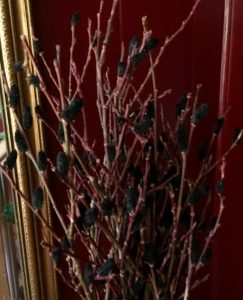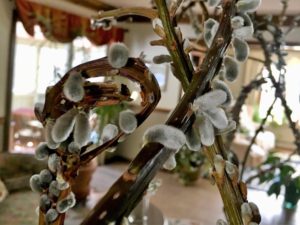Hello fellow readers,
Last week we spoke about witch hazel brightening the winter-scape with petite mops of color. Another first to show is the beloved pussy willow whose bud-like puffs of fuzz are in fact blooms. They are called catkins which seems fitting that pussy willows produce “cat-kins”, though other plants do too like birch, hickory, and chestnut.
They say the name pussy willow comes from a legend of a mother cat on a riverbank crying over her kittens who had fallen in chasing butterflies. The willows lent a hand by bending their branches into the water for the kittens to grab onto. Each spring, as the legend goes, the fuzzy pussy willow blooms are where the kittens once clung. There’s another version that had to do with a farmer annoyed his barn cat had yet another litter of kittens and opted to toss them in the river. Gratefully the story had the same happy ending and we now have spay and neuter programs.

Black Pussy Willow
Salix gracilistyla ‘Melanostachys’
Willows like damp soil and are often planted purposely to soak up wetness. They’re dioecious (die A shus) which means the male and female reproductive organs are on different plants. The male catkins are larger and showier than the more demure and slender greenish females. Both are fuzzy to keep their personal parts warm in the late winter temps. If you cut branches before the yellow pollen develops (on the males) and bring them inside as a decoration and don’t put them into water, they’ll dry and last for some time. If you put them in water they’ll easily root and make babies.
Our native pussy willow is Salix discolor, though it’s not considered a favorable landscape plant because its prone to disease and considered messy dropping twigs branches. Salix caprea, which is native to Europe and Asia, is the popular pussy willow used in landscapes. It’s also known as goat willow – caprea means goat in Latin. Their male catkins are larger than our native willow, at one to two inches long, and are pinkish grey. They quickly grow fifteen to twenty-five feet tall and wide and are used for screening or hedges and in rain gardens. Hardy in zones 4 to 8, they can handle wetness and drier soil more than other willows and thrive in full sun or part shade. And, they’re deer resistant and can grow under black walnut. Some say to cut them to the ground every three to five years to maintain them as a smaller shrub or hedge.
Because pussy willows are one of the first to bloom, they provide an important food source for early pollinators. Plus, birds use their fluffy flowers in nests and they are hosts for several species of butterflies. So, enjoy a few branches indoors but be sure to leave plenty of kitten kissed branches for our critters. Garden Dilemmas? Askmarystone.com

Japanese Fantail Willow, Salix sachalinensis ‘Sekka’ Japanese
Why Pussy Willows on Palm Sunday: Polish lore has it that Jesus walked through a forest, still stark in winter surrounds, on Palm Sunday. He asked his angels to collect fuzzy flowering branches of pussy willows, the first branches showing signs of new life. Hence, it’s become a tradition, particularly in Slavic nations, to include pussy willows in Palm Sunday services.



Lovely information! Thank you, Mary and a very Happy Easter to you!
Blessings,
April
Thank YOU, April. Here’s to spring at last! Happy Easter, Mary